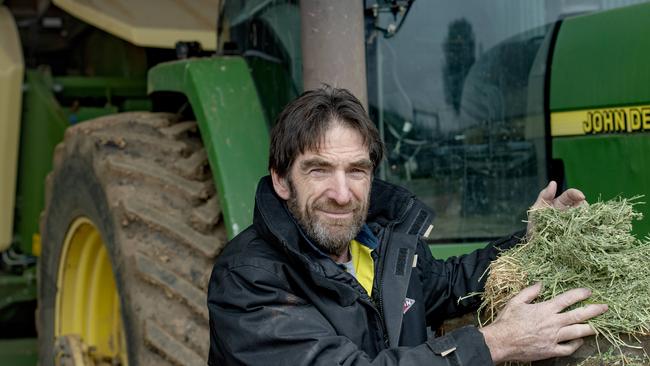Farmers weigh up selling stock versus buying in more fodder
Cattle and dairy farmers in Victoria and South Australia face rising fodder and freight costs with hay hitting 2019-levels.
Farmers are hedging their bets between high fodder and freight costs and the price of cattle in determining what to do this autumn.
Dry conditions have gripped the Western District of Victoria and South Australia, and fodder suppliers say they are sending stocks further distances to meet demand.
FodderLink managing director Cameron Angel from Toowoomba, Queensland, said his area was doing well in terms of the season.
However, it was starkly obvious how tough things were in Victoria and South Australia.
He said prices for cereal hay were at $450 to $500 a tonne delivered, and high-protein hay was making as much as $550 a tonne.
“I haven’t seen those prices since 2019,” he said.
“It is a really tough situation for cattle producers and dairy farmers.”

Australian Fodder Industry Association chairman and Jerilderie farmer Louis Kelly said the saving grace this season was the fact that cattle prices were holding up.
On Thursday the Eastern States Young Cattle Indicator was quoted at 693c/kg carcass weight to show a fall of 23c/kg in a week. But it was still 85c/kg better than this time last year.
“But with fodder there is unprecedented demand, and we are in a situation where supply is dwindling,” he said.
Mr Kelly said hay prices were 20 to 30 per cent dearer for the quality available than what was experienced in previous droughts.
“Thousands of tonnes of hay are heading from Dubbo and north to the bottom of Victoria and into the Western Districts, and as a result, we are seeing freight price pressure,” he said.
Mr Kelly said when freight calculations were considered, it was in fact the lighter categories, such as straw, which resulted in a higher cost.
“If we are looking at a 1000 kilometre journey for freight, and the bill is then around $24 a tonne for every 100km travelled, that is significant,” he said.
In a similar manner, a recent quote from a farmer showed that straw purchased for $120 a tonne at Bendigo would cost a Hamilton-area livestock producer a further $80 a tonne in freight, at $7/km for a B-Double.
Geelong-area consultant and livestock producer Cam Nicolson said farmers in the south west were having difficulty sourcing fodder, including straw, with the distance it needed to be carted a major financial consideration.
“Fodder is much harder to get hold of; grain is not too bad, but we also need the hay and straw as well and the cost of trucking that over distance has increased,” he said.
The longer the break took to arrive, the less pasture growth there was going to be ahead of stock going into winter, further increasing the need for fibre.

Timmering hay and fodder specialist Alex Peacock said the demand was high.
“We are getting a lot of inquiries from the Western District, Gippsland, and even the Upper Murray area is dry,” he said.
Mr Peacock said farmers were committed to cereal and straw, but there was plenty of interest in high-protein hay.
“Our stocks are certainly down from where they were previously.”




